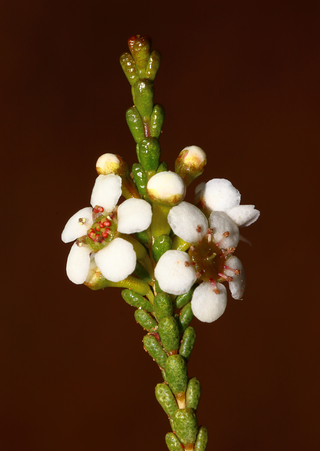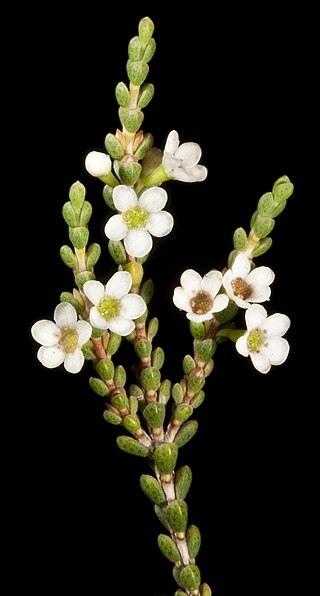Baeckea uncinella is a species of flowering plant in the family Myrtaceae and is endemic to the south coast of Western Australia. It is a shrub with narrowly egg-shaped to linear leaves and small white flowers with seven to thirteen stamens.
Micromyrtus acuta is a species of flowering plant in the myrtle family, Myrtaceae and is endemic to the southwest of Western Australia. It is an erect shrub with small, oblong leaves and small white flowers in the upper leaf axils.
Micromyrtus arenicola is a species of flowering plant in the myrtle family, Myrtaceae and is endemic to a small area in the southwest of Western Australia. It is an erect shrub with small, linear to narrowly egg-shaped leaves and small white flowers.
Micromyrtus chrysodema is a species of flowering plant in the myrtle family, Myrtaceae and is endemic to a small area of inland Western Australia. It is a densely branched shrub with small, narrowly oblong leaves and small white flowers.

Micromyrtus clavata is a species of flowering plant in the family Myrtaceae and is endemic to inland Western Australia. It is an erect, compact or sprawling shrub with erect, egg-shaped leaves with the narrower end towards the base and small white flowers arranged singly in upper leaf axils.
Micromyrtus collina is a species of flowering plant in the myrtle family, Myrtaceae and is endemic to a small area in the southwest of Western Australia. It is an erect shrub with small, linear to narrowly egg-shaped leaves and small white flowers that turn pink as they age.

Micromyrtus elobata is a species of flowering plant in the myrtle family, Myrtaceae and is endemic to the south of Western Australia. It is usually an erect shrub with small, narrowly to broadly egg-shaped leaves with the narrower end towards the base, and white flowers 3–5 mm (0.12–0.20 in) in diameter.

Micromyrtus erichsenii is a species of the family Myrtaceae and is endemic to Western Australia. It is an erect shrub with small, egg-shaped leaves with the narrower end towards the base, and white or crem-coloured flowers 3–4 mm (0.12–0.16 in) in diameter and 5 to 10 stamens.
Thryptomene duplicata is a species of flowering plant in the family Myrtaceae and is endemic to Western Australia. It is a spreading shrub with upward pointing, egg-shaped leaves with the narrower end towards the base, and white flowers with five petals and about fifteen stamens in two whorls.
Thryptomene johnsonii is a species of flowering plant in the family Myrtaceae and is endemic to a restricted area of Western Australia. It is a bushy shrub with rigid branches, egg-shaped leaves with the narrower end towards the base and pink flowers with five petals and usually eight stamens.

Thryptomene mucronulata is a species of flowering plant in the family Myrtaceae and is endemic to Western Australia. It is an erect shrub with upward-pointing, overlapping, egg-shaped leaves with the narrower end towards the base and pink flowers with five petals and ten stamens.
Thryptomene orbiculata is a species of flowering plant in the family Myrtaceae and is endemic to the west of Western Australia. It is a shrub with broadly egg-shaped to more or less round leaves, and flowers with five pinkish petals and usually ten stamens.
Thryptomene podantha is a species of flowering plant in the family Myrtaceae and is endemic to the west of Western Australia. It is a shrub with egg-shaped leaves with the narrower end towards the base, and flowers with pink sepals and petals and ten stamens.
Babingtonia fascifolia is a species of flowering plant in the family Myrtaceae and is endemic to the southwest of Western Australia. It is a shrub with erect, slender stems, linear leaves and white or pale pink flowers in groups two to seven in leaf axils, each flower with 19 to 23 stamens.

Stenanthemum intricatum is a species of flowering plant in the family Rhamnaceae and is endemic to the southwest of Western Australia. It is an erect to spreading, often wiry shrub with sparsely hairy young stems, egg-shaped to fan-shaped leaves and greyish, densely softly-hairy heads of white or cream-coloured flowers.
Stenanthemum limitatum is a species of flowering plant in the family Rhamnaceae and is endemic to the southwest of Western Australia. It is an erect or straggling shrub with sparsely hairy young stems, egg-shaped to fan-shaped leaves and greyish, softly-hairy heads of white or cream-coloured flowers.
Cryptandra micrantha is a flowering plant in the family Rhamnaceae and is endemic to the southwest of Western Australia. It is a prostrate or upright shrub with spiny branchlets, narrowly oblong to elliptic leaves and dense clusters of white or cream-coloured, tube-shaped flowers.

Stenanthemum nanum is a species of flowering plant in the family Rhamnaceae and is endemic to the south-west of Western Australia. It is a prostrate shrub with hairy young stems, broadly egg-shaped leaves with the narrower end towards the base, and densely silvery-hairy heads of white or cream-coloured flowers.
Stenanthemum notiale is a species of flowering plant in the family Rhamnaceae and is native to Western Australia, South Australia and Victoria. It is a small, erect to prostrate shrub with hairy young stems, egg-shaped leaves with the narrower end towards the base, and clusters of white to cream-coloured or greenish yellow, densely shaggy-hairy flowers.
Pimelea pelinos is a species of flowering plant in the family Thymelaeaceae and is endemic to a small area in the southwest of Western Australia. It is an erect, straggling shrub with narrowly egg-shaped leaves, the narrower end towards the base, and erect clusters of cream-coloured, unisexual flowers surrounded by 2 or 4 egg-shaped, leaf-like involucral bracts.






